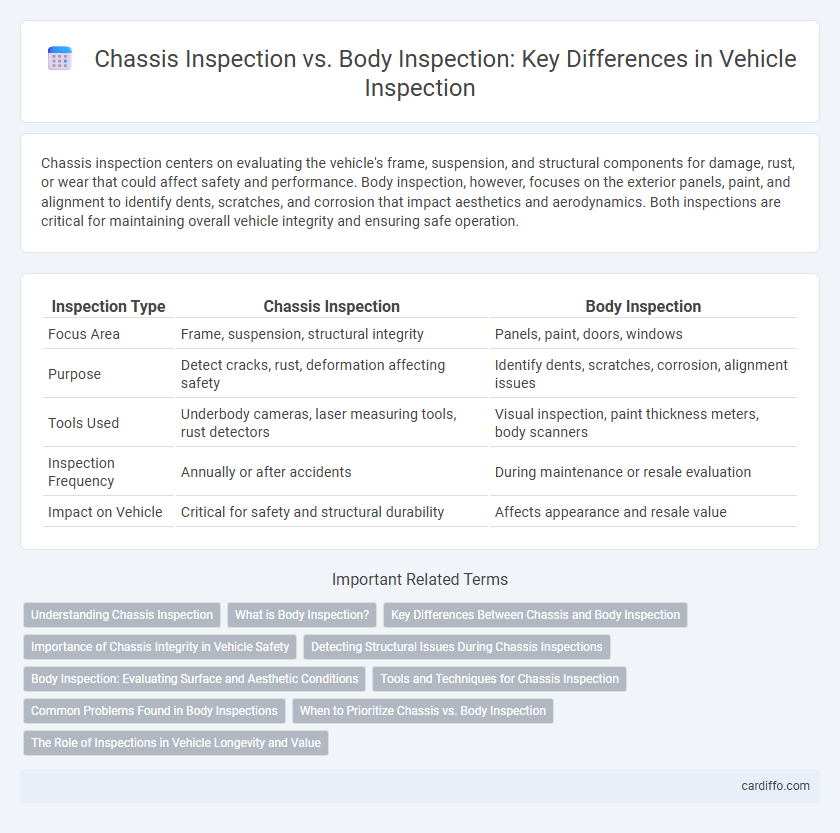Chassis inspection centers on evaluating the vehicle's frame, suspension, and structural components for damage, rust, or wear that could affect safety and performance. Body inspection, however, focuses on the exterior panels, paint, and alignment to identify dents, scratches, and corrosion that impact aesthetics and aerodynamics. Both inspections are critical for maintaining overall vehicle integrity and ensuring safe operation.
Table of Comparison
| Inspection Type | Chassis Inspection | Body Inspection |
|---|---|---|
| Focus Area | Frame, suspension, structural integrity | Panels, paint, doors, windows |
| Purpose | Detect cracks, rust, deformation affecting safety | Identify dents, scratches, corrosion, alignment issues |
| Tools Used | Underbody cameras, laser measuring tools, rust detectors | Visual inspection, paint thickness meters, body scanners |
| Inspection Frequency | Annually or after accidents | During maintenance or resale evaluation |
| Impact on Vehicle | Critical for safety and structural durability | Affects appearance and resale value |
Understanding Chassis Inspection
Chassis inspection involves a detailed assessment of the vehicle's frame, suspension, steering components, and undercarriage to ensure structural integrity and safety. This process helps detect issues such as cracks, rust, and misalignment that can compromise vehicle performance and driver safety. Understanding the chassis inspection process is crucial for maintaining vehicle durability and preventing costly repairs caused by undetected damage.
What is Body Inspection?
Body inspection involves a detailed examination of the vehicle's exterior and structural components to identify damages, corrosion, alignment issues, and paint defects. This process ensures the integrity of panels, doors, windows, and surface coatings, crucial for vehicle safety and aesthetics. Body inspection complements chassis inspection by focusing on visible elements rather than the underlying frame and mechanical parts.
Key Differences Between Chassis and Body Inspection
Chassis inspection focuses on assessing the vehicle's frame, suspension, steering components, and undercarriage for structural integrity and damage, ensuring safety and performance. Body inspection primarily examines the exterior panels, paint, doors, windows, and alignment to detect cosmetic issues, corrosion, and fitment errors. Key differences involve the chassis inspection's emphasis on mechanical and load-bearing parts, while body inspection targets surface condition and aesthetic defects.
Importance of Chassis Integrity in Vehicle Safety
Chassis inspection ensures the structural framework of a vehicle remains intact, directly affecting overall safety and handling performance. Unlike body inspection, which focuses on cosmetic and external damage, chassis inspection identifies critical issues like frame cracks and corrosion that can compromise crash protection and vehicle stability. Maintaining chassis integrity is essential for preventing accidents and ensuring a vehicle meets safety standards on the road.
Detecting Structural Issues During Chassis Inspections
Chassis inspections are critical for detecting structural issues such as frame cracks, corrosion, and misalignment that compromise vehicle safety and performance. Unlike body inspections that focus on cosmetic damages and panel fitment, chassis inspections involve a thorough examination of key components like suspension mounts, cross members, and welds to identify hidden weaknesses. Early detection of chassis defects helps prevent costly repairs and ensures compliance with safety standards.
Body Inspection: Evaluating Surface and Aesthetic Conditions
Body inspection involves a detailed evaluation of a vehicle's surface and aesthetic conditions, including checking for dents, scratches, paint quality, and corrosion. This process ensures that the vehicle maintains its exterior integrity and visual appeal, which are critical for resale value and overall vehicle condition assessment. Advanced techniques such as paint thickness measurement and visual surface analysis help detect imperfections and potential damage not visible to the naked eye.
Tools and Techniques for Chassis Inspection
Chassis inspection relies heavily on precision tools such as dial indicators, ultrasonic thickness gauges, and chassis alignment machines to detect structural integrity issues and material fatigue. Techniques include non-destructive testing methods like magnetic particle inspection and dye penetrant testing, which reveal cracks and corrosion without damaging the chassis. Advanced scanning technologies, including 3D laser scanners, enable detailed measurements to ensure proper frame geometry and alignment.
Common Problems Found in Body Inspections
Body inspections commonly reveal issues such as corrosion on panels, misaligned doors, and damaged paintwork from scratches or dents. These problems can compromise vehicle aesthetics and structural integrity, often resulting from environmental exposure or minor collisions. Identifying these defects early is essential to prevent rust development and costly repairs.
When to Prioritize Chassis vs. Body Inspection
Prioritize chassis inspection when assessing vehicle safety, structural integrity, and suspension system performance, especially after impacts or harsh terrain use. Focus on body inspection for cosmetic damage, rust detection, and alignment issues following accidents or prolonged exposure to environmental elements. Understanding the vehicle's usage history and visible wear patterns helps determine the optimal inspection priority.
The Role of Inspections in Vehicle Longevity and Value
Chassis inspection plays a critical role in ensuring vehicle longevity by identifying structural damage, corrosion, and wear that compromise safety and performance. Body inspection complements this by detecting cosmetic defects, alignment issues, and rust that affect the vehicle's aesthetic value and resale price. Together, these inspections maintain overall integrity, enhance durability, and protect the vehicle's market value over time.
Chassis inspection vs body inspection Infographic

 cardiffo.com
cardiffo.com